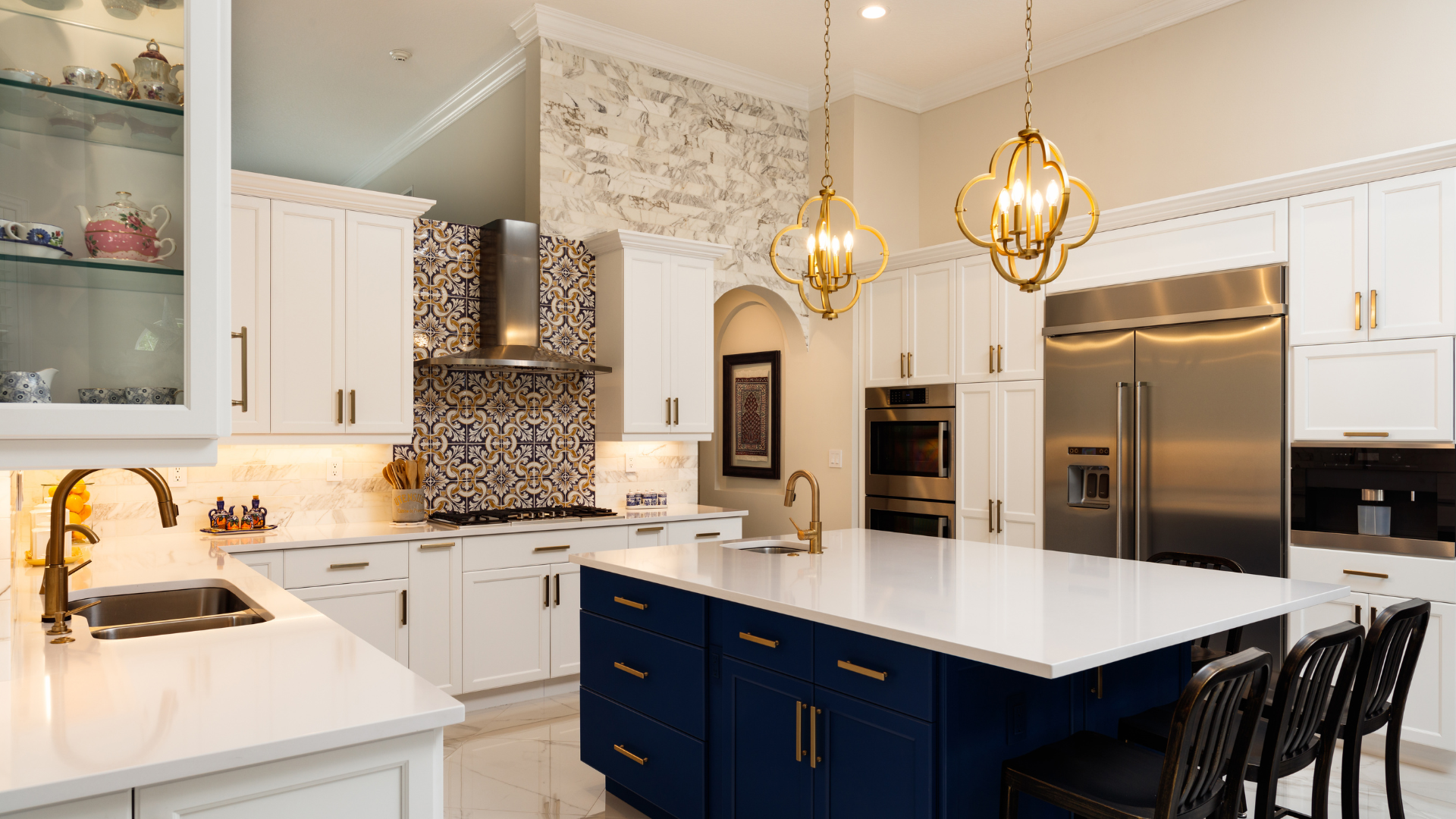The heart of every home, the kitchen, is undergoing a fascinating transformation as we step into the future of kitchen design. In this blog post, we’ll explore some exciting innovations and trends that are reshaping the way we think about kitchens. From two islands in one kitchen to sustainable materials and smart appliances, the kitchen of tomorrow is a place where form meets function with a dash of style and comfort.
Trend 1: Two Islands, One Kitchen
Imagine a kitchen with not one, but two islands! It’s a trend that’s making waves in the world of kitchen design. Here’s why kitchens with two islands are catching on:
- Increased Workspace: Having two islands means more countertop space to work on. Whether you’re preparing a family dinner or hosting a gathering, extra workspace is always a plus.
- Multifunctional Zones: One island can be dedicated to meal prep, while the other serves as a breakfast bar or a space for guests to gather around. It creates a seamless flow in the kitchen.
- Design Aesthetics: Two islands can be designed in different styles, materials, or colors, adding visual interest and character to the kitchen.
- Entertaining Made Easy: When you have two islands, it’s easier to keep the cooking area separate from the social space, making it a breeze to entertain while you cook.
Trend 2: Sustainable Materials Take Center Stage
In the future, making kitchens sustainable is really important. People who own homes and designers are starting to use eco-friendly materials more and more. They do this because it’s good for the environment and it looks nice too. Even when homeowners work with renovation experts, like the ones at www.bkpatterson.co.nz, they often talk about using sustainable materials in their kitchen designs. Here are some of the sustainable materials that are among the top choices:
- Bamboo Countertops: Bamboo is a rapidly renewable resource that’s gaining popularity as a countertop material. It’s durable, stylish, and eco-friendly.
- Recycled Glass Backsplashes: Glass backsplashes made from recycled bottles and jars are not only visually stunning but also reduce waste and energy consumption.
- Cork Flooring: Cork is not just for wine bottles; it’s also an excellent flooring choice. It’s soft underfoot, resistant to moisture, and harvested from sustainable cork oak trees.
- Reclaimed Wood Cabinets: Reclaimed wood brings warmth and character to your kitchen. Using wood from old barns or factories reduces the demand for new timber.
Trend 3: The Rise of Smart Appliances
In the modern era, the kitchen of tomorrow emphasizes convenience and efficiency. It’s becoming increasingly common for people to turn to Luxury Designer Kitchens From Nicholas Anthony or similar companies to revolutionize cooking experiences and interactions within kitchen spaces. Here are some exciting advancements:
- Connected Refrigerators: These refrigerators can let you know when you’re running low on certain items, helping you create shopping lists. Some even have built-in cameras so you can see what’s inside without opening the door.
- Voice-Activated Controls: Imagine telling your oven to preheat or asking your fridge for a recipe while your hands are covered in flour. Voice-activated controls make it possible.
- Induction Cooktops: Induction cooktops are not only energy-efficient but also safer to use. They heat up instantly and cool down quickly, reducing the risk of burns.
- Smart Faucets: Smart faucets with touchless controls not only save water but also make cleaning up a breeze.
Trend 4: Minimalism and Open Shelving
Simplicity is the name of the game in the future of kitchen design. Minimalist kitchens with open shelving are becoming increasingly popular for several reasons:
- Airy and Spacious Feel: Open shelving creates an open and spacious atmosphere, making your kitchen feel less cluttered.
- Easy Access: With open shelves, everything you need is within arm’s reach, making cooking and meal prep more efficient.
- Showcasing Decor: Open shelves allow you to display your favorite dishes, cookware, and decorative items, adding a personal touch to your kitchen.
- Less Maintenance: Cabinets with doors require handles and knobs, which can collect dirt and grime. Open shelving is easy to clean and maintain.
Trend 5: Mixed Materials for Texture and Contrast
Kitchen designers are embracing the concept of mixing and matching materials to create visual interest and depth in kitchen spaces. Here’s how:
- Contrasting Countertops: Pairing dark countertops with light cabinets or vice versa creates a striking contrast that adds drama to your kitchen.
- Textured Backsplashes: Textured backsplashes made from materials like subway tiles, shiplap, or 3D tiles add dimension to your kitchen walls.
- Matte Finishes: Matte finishes on appliances and Kitchen and Bathroom Cabinets are gaining popularity due to their modern and sleek appearance.
- Metallic Accents: Copper, brass, and black stainless steel are making a comeback as accents in kitchen hardware, faucets, and lighting fixtures.
Trend 6: Integrated Technology for a Seamless Look
In the future, technology in the kitchen is seamlessly integrated into the design, rather than standing out as an eyesore. Here’s how it’s being done:
- Hidden Charging Stations: Charging stations for devices are concealed within drawers or cabinets, keeping your kitchen clutter-free.
- Under-Cabinet Lighting: LED lighting strips under cabinets provide both functional illumination and a touch of modernity to your kitchen.
- Appliance Garages: Appliance garages are cleverly designed storage areas that keep countertop appliances out of sight when not in use.
- Smart Storage Solutions: Cabinets with pull-out shelves, pantry organizers, and deep drawers maximize storage and keep everything in its place.
Trend 7: Biophilic Design for a Natural Touch
Biophilic design, which incorporates natural elements into the kitchen, is gaining traction for its calming and inviting ambiance:
- Indoor Plants: Bringing in potted plants or herbs adds a refreshing touch of greenery to your kitchen, improving air quality and reducing stress.
- Natural Light: Designing kitchens to maximize natural light through large windows or skylights creates a warm and inviting atmosphere.
- Organic Materials: Using materials like wood, stone, and natural fibers in your kitchen design adds a tactile connection to nature.
Nevertheless, if we are not happy with how our kitchen looks or functions, no worries! Remodeling opens up a world of possibilities. With smart appliances making tasks easier, a mix of materials adding charm, and open shelving bringing simplicity, a reliable Kitchen remodeling company can build us a kitchen that’s more than just a cooking space. Whether we want to make it more efficient, update its style, or just give it a fresh feel, remodeling allows us customize our kitchen to suit our changing tastes and needs.
As we peer into the future of kitchen design, we see a world where functionality, sustainability, and aesthetics come together seamlessly. From the convenience of smart appliances to the beauty of mixed materials and the simplicity of open shelving, these trends are shaping kitchens that are not just spaces for cooking but also for living, entertaining, and creating cherished memories.
So, whether you’re planning a kitchen remodel or simply daydreaming about your dream kitchen, these innovations and trends are sure to inspire you to create a kitchen that’s perfect for your needs and style.


